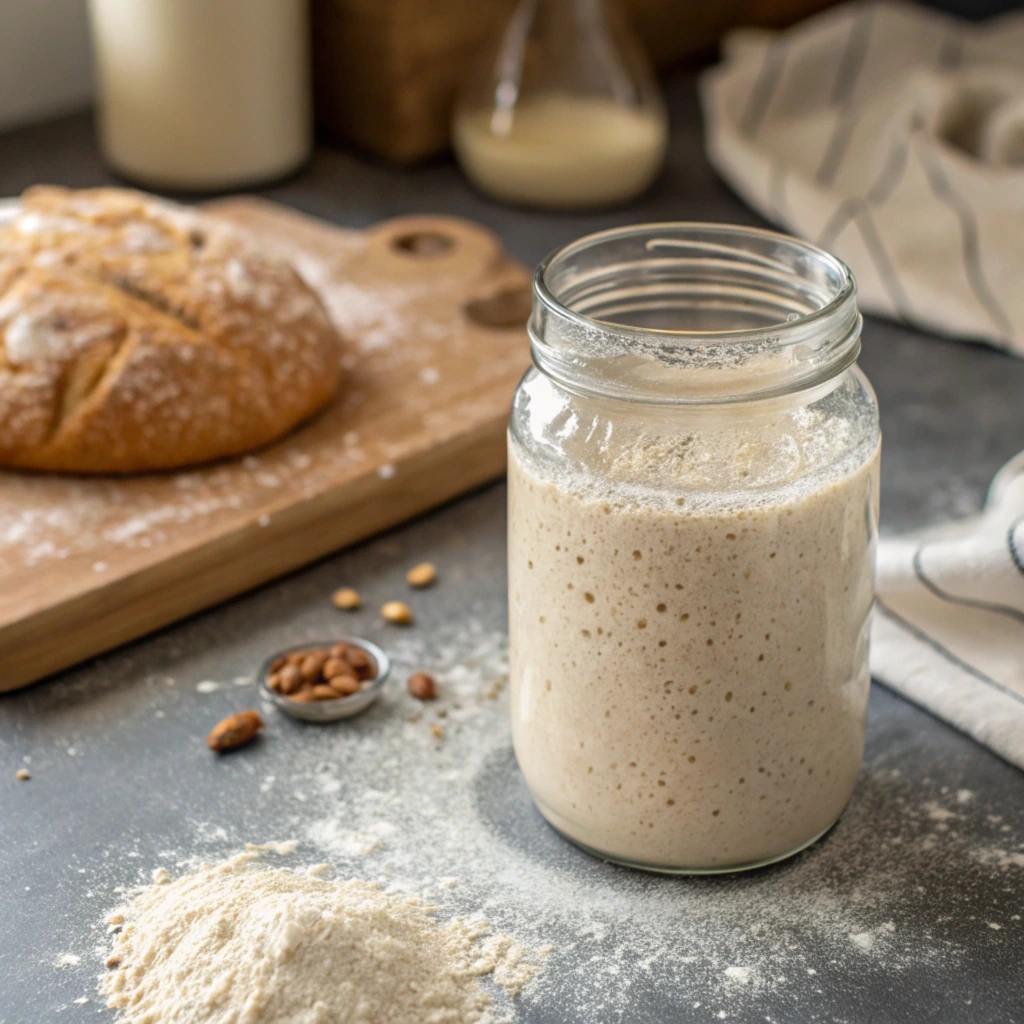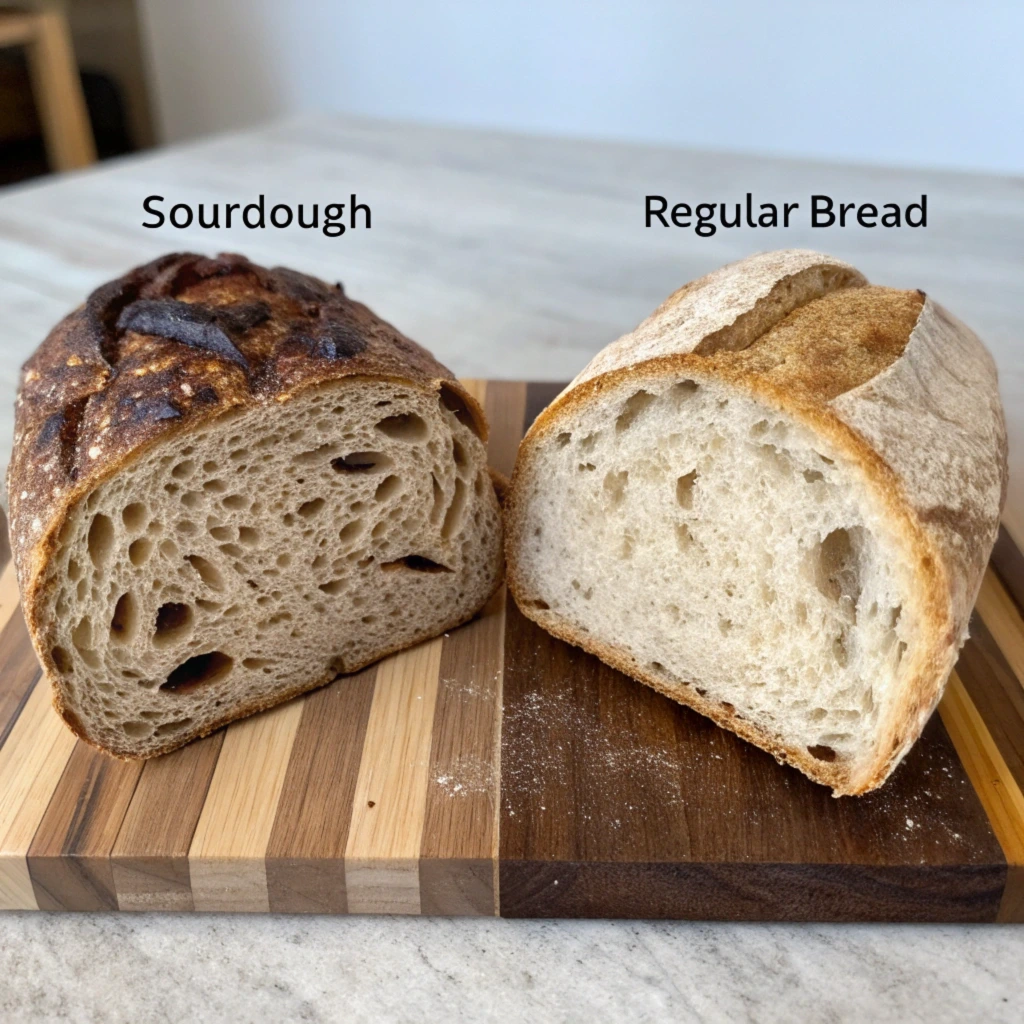Sourdough bread has become increasingly popular, but many wonder, is sourdough healthier for you than regular bread? This question arises from sourdough’s unique fermentation process, which is thought to offer health benefits not found in regular bread. By understanding these differences, we can better determine if sourdough is a healthier choice.
Unlike regular bread, sourdough undergoes a slow fermentation process that improves its nutrient profile and digestibility. For those questioning, is sourdough healthier for you than regular bread, the lower glycemic index of sourdough is a critical factor. This slower glucose release helps maintain steady energy levels and may benefit people with blood sugar concerns.
Additionally, people often debate the health implications of bread types. Comparing the digestibility of sourdough to regular bread, many find sourdough gentler on the stomach. This naturally leads to the common question: is sourdough healthier for you than regular bread, especially for individuals with mild gluten sensitivities.
The choice between sourdough and regular bread ultimately depends on personal priorities. Whether you’re seeking improved digestion, better nutrient absorption, or just a delicious alternative, sourdough makes a compelling case. So, is sourdough healthier for you than regular bread? With its unique benefits, many would argue yes!
Introduction and Overview
What Makes Bread a Staple Food Across Cultures?
Bread is one of humanity’s oldest prepared foods, serving as a dietary cornerstone for millennia. From flatbreads to fluffy loaves, it provides a versatile canvas for countless cuisines. But not all bread is created equal. Modern bread often undergoes rapid production processes that compromise its nutritional value, leading many to search for alternatives like sourdough.
The Rise of Sourdough: A Nutritional Wonder or Just a Trend?
Sourdough has gained a devoted following, thanks to its rustic charm and perceived health benefits. Made using a simple mix of flour, water, and naturally occurring wild yeast, sourdough’s long fermentation process sets it apart from regular bread. This process doesn’t just affect taste—it also has implications for the bread’s digestibility, nutritional content, and how it impacts blood sugar levels.
A Glimpse at Regular Bread: Convenience Over Nutrition
Regular bread, often mass-produced with commercial yeast, focuses on efficiency and uniformity. While it’s an affordable and convenient option, some argue it pales in comparison to sourdough when it comes to taste and health benefits.
Key Questions This Article Will Answer
- What are the differences between sourdough and regular bread?
- Is sourdough bread more nutritious?
- How does sourdough affect digestion and gluten sensitivity?
- Are there downsides to choosing sourdough over regular bread?
By the end of this article, you’ll have a comprehensive understanding of whether sourdough deserves its place as a healthier option in your diet. Let’s dive deeper!
Understanding Sourdough and Regular Bread
What is Sourdough Bread?
Sourdough bread is crafted through an age-old fermentation process that relies on wild yeast and lactic acid bacteria. Unlike regular bread, sourdough doesn’t use commercial yeast for leavening. Instead, it’s made with a “starter,” a lively mixture of flour and water that ferments naturally over time. This slow fermentation gives sourdough its tangy flavor, chewy texture, and distinctively crisp crust.
The process isn’t just about taste. Fermentation breaks down some of the carbohydrates and gluten in the flour, which could make sourdough easier to digest for some people. Additionally, the presence of beneficial bacteria in the starter contributes to its potential health benefits.

What Constitutes Regular Bread?
Regular bread, also known as conventional or commercial bread, is typically made with refined flour and baker’s yeast. Baker’s yeast accelerates the leavening process, enabling large-scale production in a short time. While this approach ensures consistency and affordability, it skips the extended fermentation that characterizes sourdough, potentially affecting the bread’s nutritional profile.
The convenience of regular bread has made it a global favorite. However, its ingredients often include additives and preservatives to prolong shelf life and improve texture, raising questions about its overall healthiness.
Key Differences Between Sourdough and Regular Bread
To understand the debate between sourdough bread and regular bread, let’s explore their main differences:
- Fermentation Process: Sourdough uses wild yeast and bacteria for a slow, natural fermentation. Regular bread relies on baker’s yeast for quicker production.
- Flavor Profile: Sourdough’s long fermentation gives it a tangy, complex flavor, while regular bread is milder.
- Texture and Appearance: Sourdough often boasts a chewy texture with a crisp crust, while regular bread is typically softer and more uniform in appearance.
- Preservatives: Sourdough naturally resists spoilage thanks to lactic acid, whereas regular bread often contains chemical preservatives.
The Role of Traditional Methods
Traditional methods of preparing sourdough align with what many health experts consider wholesome. For those wondering, is sourdough healthier for you than regular bread, its reliance on simple, natural ingredients stands out. Unlike regular bread, sourdough avoids additives and embraces a slow fermentation process, providing a purer bread experience.
This difference highlights a key debate: is sourdough healthier for you than regular bread when considering nutrition and taste? Modern bread production, which prioritizes speed and volume, often sacrifices these qualities. Meanwhile, sourdough’s traditional approach preserves nutrients and enhances flavor, making it a popular choice for health-conscious individuals.
For anyone asking, is sourdough healthier for you than regular bread, the answer often lies in its natural preparation methods. These methods ensure a product that’s easier to digest, richer in nutrients, and free of unnecessary chemicals. By avoiding shortcuts, sourdough offers a wholesome and authentic bread experience that regular bread struggles to match. So, is sourdough healthier for you than regular bread? Its simplicity and health benefits make a strong case.
Nutritional Comparison
Nutrient Content in Sourdough vs. Regular Bread
When it comes to nutrition, sourdough bread holds its own against regular bread. The fermentation process in sourdough is more than just a culinary technique—it enhances the bread’s nutrient profile in several ways.
- Increased Mineral Absorption: The lactic acid bacteria in sourdough reduce phytates, compounds that bind to minerals like iron, zinc, and magnesium, and inhibit their absorption. As a result, sourdough allows your body to extract more nutrients from the bread.
- Vitamin Boost: Sourdough contains higher levels of certain vitamins, such as folate and B vitamins, compared to regular bread.
- Rich in Antioxidants: The fermentation process can increase antioxidant levels, which help combat oxidative stress in the body.
In contrast, regular bread, especially when made with refined flour, may lack these enhanced nutritional benefits. While it may be fortified with added vitamins and minerals, the synthetic nature of these additives may not compare to naturally bioavailable nutrients.

Glycemic Index and Blood Sugar Response
One of the most significant health claims surrounding sourdough bread is its impact on blood sugar levels. With a lower glycemic index (GI) than many regular breads, sourdough causes a slower, more gradual rise in blood sugar.
Here’s why:
- The long fermentation process breaks down starches, making them less readily available for digestion.
- The organic acids produced during fermentation slow down the release of glucose into the bloodstream.
Regular bread, particularly white bread, has a much higher GI. It leads to rapid spikes in blood sugar, which may be concerning for individuals managing diabetes or insulin resistance.
Why Does This Matter?
The glycemic index isn’t just a buzzword. It directly impacts how bread fits into a balanced diet. Low-GI foods like sourdough bread may help:
- Maintain steady energy levels throughout the day.
- Reduce the risk of developing type 2 diabetes.
- Improve overall metabolic health.
By comparison, the higher GI of regular bread can contribute to energy crashes, cravings, and potential long-term health issues.
Nutritional Summary Table
| Nutritional Aspect | Sourdough Bread | Regular Bread |
|---|---|---|
| Mineral Absorption | Higher (due to reduced phytates) | Moderate |
| Vitamin Content | Naturally rich in B vitamins | Often fortified |
| Glycemic Index (GI) | Lower | Higher |
| Antioxidants | Higher | Lower |
Sourdough’s nutritional advantages make it an attractive option for those looking to boost their dietary health. Next, let’s see how these differences translate into real health impacts!
Health Implications
Digestibility and Gut Health
One of the most praised aspects of sourdough bread is its digestibility. Unlike regular bread, sourdough undergoes a natural fermentation process that partially breaks down gluten and starches, making it easier for many people to digest. Here’s how:
- Pre-digestion of Gluten: The bacteria in the sourdough starter work to break down gluten proteins, potentially reducing symptoms for individuals with mild gluten sensitivity.
- Increased Prebiotics: The fermentation process creates prebiotics, compounds that feed beneficial gut bacteria and support a healthy microbiome.
- Reduced FODMAPs: For individuals with irritable bowel syndrome (IBS), sourdough may be easier on the stomach due to lower levels of FODMAPs, fermentable carbs that can cause bloating and gas.
In contrast, regular bread is less likely to offer these benefits. Its rapid production process skips the extended fermentation that enhances digestibility.
Impact on Gluten Sensitivity
While sourdough bread isn’t suitable for people with celiac disease, it may be a better option for those with non-celiac gluten sensitivity (NCGS). The fermentation process breaks down parts of the wheat that often trigger symptoms, such as bloating or discomfort. That said, it’s crucial for individuals with severe sensitivities to consult a healthcare provider before incorporating sourdough into their diets.
Regular bread, on the other hand, lacks this advantage. Its shorter fermentation process leaves most of the gluten intact, potentially exacerbating symptoms for those with gluten sensitivity.
Potential Antioxidant Benefits
Did you know that sourdough bread is a natural source of antioxidants? These compounds help combat free radicals, molecules that can damage cells and contribute to aging and disease. The fermentation process amplifies the production of certain antioxidants, making sourdough bread a functional food in addition to being delicious.
Regular bread, particularly white or highly processed varieties, tends to have fewer naturally occurring antioxidants. This nutritional shortfall makes sourdough an appealing option for those prioritizing foods rich in antioxidants.
A Balanced Perspective on Health
It’s worth noting that while sourdough bread offers unique health benefits, moderation is key. Even sourdough can contribute to excess calorie intake if consumed in large quantities, especially when paired with calorie-dense toppings. However, its nutrient density and digestibility give it an edge over regular bread as part of a balanced diet.
With these health implications in mind, it’s easy to see why sourdough is often hailed as a superior choice. But how does it perform in everyday use? Let’s explore its practical advantages!
Practical Considerations
Shelf Life and Preservation
One standout advantage of sourdough bread over regular bread is its naturally longer shelf life. This is due to the presence of lactic acid bacteria, which act as a natural preservative. These bacteria create an acidic environment that inhibits the growth of mold and other spoilage organisms.
Here’s how sourdough’s shelf life compares:
- Sourdough Bread: Can last up to 4–5 days at room temperature, and even longer if stored in a paper bag or bread box.
- Regular Bread: Often starts to go stale or moldy within 2–3 days without preservatives.
If you’re looking for a way to reduce food waste or simply enjoy your bread longer, sourdough’s extended shelf life is a practical perk.
Taste and Culinary Uses
Sourdough’s distinctive flavor and texture make it a favorite among home cooks and professional chefs alike. Its tangy, slightly sour taste is a result of the fermentation process, which develops complex flavors unmatched by most regular bread.
Culinary Uses of Sourdough Bread:
- Sandwiches: The chewy texture and hearty crust of sourdough hold up well to hearty fillings.
- Toasts and Bruschetta: Sourdough’s crisp crust and tangy flavor pair beautifully with toppings like avocado, eggs, or fresh tomatoes.
- Soups and Stews: The sturdy slices are perfect for dunking into hearty soups or using as a base for thick stews.
Regular Bread’s Role: While regular bread may be softer and easier to work with for certain recipes, it lacks the nuanced flavor and satisfying texture that make sourdough so versatile.

How Does Regular Bread Stack Up in Practicality?
Regular bread’s biggest strength lies in its convenience. It’s widely available, affordable, and easy to slice or store. However, this convenience often comes at the expense of flavor, texture, and even nutritional value.
Choosing Based on Lifestyle
While sourdough has many advantages, it may require a little more effort to find or prepare. Regular bread, by comparison, is accessible in almost every grocery store. The choice ultimately depends on your priorities—whether you value flavor and health benefits or prioritize convenience and cost.
Next, let’s address some common questions about sourdough and regular bread to clear up any lingering doubts!
Frequently Asked Questions
Is sourdough bread healthier than regular bread?
Yes, sourdough bread offers several health advantages over regular bread. Its fermentation process improves nutrient absorption, lowers the glycemic index, and enhances digestibility. Additionally, sourdough contains natural antioxidants and prebiotics, making it a more nutrient-dense choice.
Does sourdough bread have a lower glycemic index than regular bread?
Absolutely! The glycemic index of sourdough is lower due to the fermentation process, which breaks down carbohydrates into simpler, slower-releasing sugars. This means sourdough causes a gradual rise in blood sugar levels, unlike regular bread, which can lead to spikes.
Is sourdough bread easier to digest than regular bread?
For many people, sourdough is easier to digest. The natural fermentation partially breaks down gluten and starches, making the bread less taxing on the digestive system. It’s especially helpful for individuals with mild gluten sensitivities or IBS.
Can people with gluten sensitivity eat sourdough bread?
People with non-celiac gluten sensitivity may find sourdough bread more tolerable than regular bread, as fermentation reduces gluten levels. However, those with celiac disease should avoid sourdough unless specifically made with gluten-free flour.
Does sourdough bread have a longer shelf life?
Yes, sourdough bread naturally resists mold and spoilage thanks to the lactic acid bacteria produced during fermentation. It stays fresh longer than regular bread without relying on artificial preservatives.
What are the taste differences between sourdough and regular bread?
Sourdough has a tangy, complex flavor with a chewy texture and crisp crust, while regular bread is milder in taste and softer in texture. Sourdough’s unique taste comes from its slow fermentation, which develops rich, nuanced flavors.
How do I know if sourdough bread is right for me?
Consider your dietary goals and preferences. If you’re looking for a nutritious, flavorful option with digestive benefits, sourdough might be ideal. However, if convenience and softness are more important, regular bread could fit better into your routine.
Next, we’ll wrap up this exploration by helping you make an informed choice about which type of bread is right for you!
Making an Informed Choice
Is Sourdough the Healthier Choice?
After comparing sourdough bread and regular bread, it’s clear that sourdough offers several unique advantages. Its natural fermentation process not only enhances flavor and texture but also provides significant health benefits like improved digestibility, lower glycemic index, and better nutrient absorption. For individuals seeking a nutritious and satisfying option, sourdough is a strong contender.
When Regular Bread Might Be a Better Fit
That said, regular bread isn’t entirely without merit. It’s:
- Affordable and widely available.
- Easier to store and slice.
- A convenient option for those who prioritize cost and accessibility over health benefits.
If you have no specific dietary concerns and prefer a softer, milder bread, regular bread might suit your lifestyle better.
Balancing Flavor, Nutrition, and Practicality
Ultimately, the choice between sourdough and regular bread depends on your personal needs. If you enjoy baking, sourdough can be a rewarding homemade project that connects you to age-old culinary traditions. On the other hand, if you lead a busy lifestyle and need a quick, reliable option, regular bread may align better with your routine.
Final Thought: A Bread for Every Occasion
Whether you choose sourdough or regular bread, both can have a place in a balanced diet. The key is moderation and selecting high-quality ingredients. For those interested in maximizing their bread’s health potential, sourdough’s benefits make it worth the extra effort.

